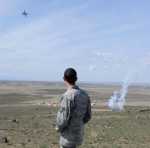Air Force considering closing or limiting operations at training ranges in the United States

The United States Air Force is considering ordering training ranges around the country -- including the ranges at Mountain Home Air Force Base -- to be shut down or sharply curtail operations due to the budget constraints of sequestration.
Col. Christopher Short, 366th Fighter Wing Commander at Mountain Home AFB, said that there are discussions being held by top Air Force officials about the possibility of cutting back at some training ranges and the local training range complex "is one of ten smaller ranges being considered."
Air Combat Command Commander Gen. Mike Hostage, Short's boss, "has talked about the possibility" of closing some ranges across the continental United States due to the effects of sequestration, he said.
A spokesperson for Sen. Mike Crapo's office said, "The Pentagon has not yet decided what to do about the (Idaho) training range," however.
"That decision is 'to be determined'," said Lindsay Northern, Crapo's spokesperson.
The Saylor Creek training range and the Idaho Training Range in southern Idaho primarily support Mountain Home Air Force Base and the Idaho Air National Guard, as well as other foreign and domestic military air forces. They are operated by 130 full-time members of the Guard's 266th Range Squadron (RANS).
According to Col. Tim Marsano, public affairs officer for the Idaho National Guard, "the affects on our airmen will be minimal. If there's less flying, fewer guys will be going down to the range."
The RANS unit operates the "enemy" radar threat emitters and fires small "Smokey SAM" rockets that simulate attacks on aircraft by ground-based Surface-to-Air Missile systems.
Marsano noted that the members of the RANS unit are full-time active duty guardsmen "and there are plenty of things they can do, such as get caught up on some (specialized) training and maintenance. We're not going to be losing any people."
Two weeks ago, the Air Force, in the face of massive budget cuts and sequestration cutbacks imposed on it by Congress, grounded more than a third of its fleet of aircraft. Only those units deployed, or training for deployment, were unaffected. At Mountain Home AFB, that meant that of the two United States Air Force flying squadrons at the base, the 391st Fighter Squadron was grounded while the 389th Fighter Squadron continued to train until its deployment to southwest Asia Tuesday in support of the war in Afghanistan.
Combat certifications for pilots who don't train expire in roughly 120 days. The 389th is believed to be one of the last USAF squadrons to be trained for a combat deployment. In any future crisis, units that have not been training may have to be used.
Currently, under the sequestration cuts, pilots of grounded squadrons are conducting what training is possible on simulators, and the ground crews are getting caught up on maintenance. Some planes around the country are simply being parked -- and hauled around the ramps once a week to prevent tire rot.
The airspace for the base's training, known as a Military Operating Area, is technically unaffected by these orders, but there may not be many USAF aircraft to fly in it while sequestration is in effect. Under the rules of sequestration set up by Congress, the federal government must make across-the-board cuts in every line item of its budget until Congress can reach agreement on a balanced budget and debt reduction.
Unaffected by the order to ground USAF units was the 428th Fighter Squadron, a training unit of the Republic of Singapore air force.
Col. Short said that the Air Force would comply with its Memoradum of Understanding with the republic, which has a 25-year deal with the Air Force to use the base for training.
Short said even if range operations are curtailed to some degree the 428th's "Buccaneers" will still be able to use the military operating area. "They just wouldn't be able to drop" on the ranges. However, he stressed, every effort was being made to delay any impacts that might affect the training range complex long as possible.
He pointed out that besides the Republic of Singapore squadron, "we have other customers" who use the range, such as the electronic warfare EAF-18s from Widbey Island Naval Air station that are visiting the base this week to use the ranges. "The emitters on our range are very useful tools" for training aircraft, he pointed out.
In addition, he said, "You can't just shut this thing down 'cold turkey'. There are contracts and commitments that would have to be met." He said it would take at least 60 days to close the range if that were the decision that was made, but felt it was more likely that the operations might be reduced.
In addition, Short pointed out, Gen. Hostage is trying to keep open the extensive Nellis AFB range complexes and the Utah Test and Training Range (UTTR), one of the few ranges in the nation where live bombs can be dropped. Mountain Home Air Force Base units have often used the UTTR as part of their training, which could still be used if it remains open and there were any changes to the local range.
The Mountain Home News had indicated earlier today that a decision actually had been made to close or curtail operations at some bases (not specifically identified), based on four different usually reliable sources within the military, but Short said no decision by Gen. Hostage is likely to be made until at least the end of the month.
